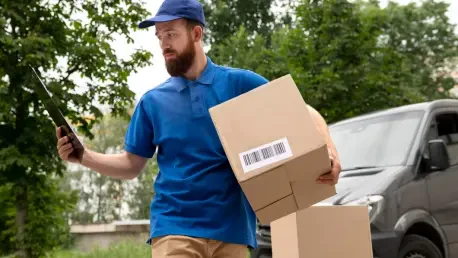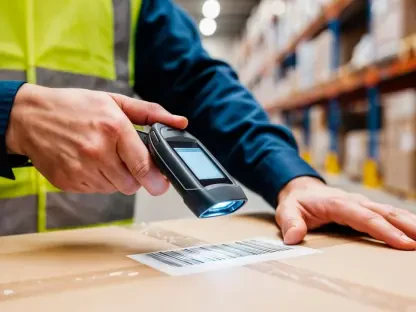The Boom of E-Commerce and Package Deliveries in NYC
The streets of New York City are buzzing more than ever, not just with the usual hustle of pedestrians and taxis, but with an unprecedented flood of delivery trucks and couriers racing to meet the demands of online shopping. This surge in e-commerce has transformed consumer habits, making same-day or next-day delivery a standard expectation for millions of residents. What was once a convenience has now become a cornerstone of daily life, with delivery vans weaving through tight urban corridors at all hours, spotlighting both the marvel of modern logistics and the strain it places on a densely populated metropolis.
Statistics paint a striking picture of this growth. Daily package deliveries have climbed to an estimated 2.5 million across the city, a significant leap from just a few years prior, reflecting the insatiable demand for quick shipping. Major players like Amazon and FedEx dominate this landscape, operating vast networks of last-mile warehouses to ensure rapid turnaround times. Their presence underscores the critical role of logistics in sustaining consumer satisfaction and driving economic activity, as e-commerce contributes billions to the local economy through jobs and commerce.
Yet, this boom carries a darker side that cannot be ignored. While the ability to order goods with a click benefits countless households, the ripple effects are felt in clogged streets, compromised safety, and environmental strain. The sheer volume of deliveries has begun to reshape urban life in ways that challenge the balance between convenience and livability, setting the stage for a deeper examination of how this industry impacts the city’s fabric.
Impacts of Last-Mile Deliveries on Urban Safety and Environment
Rising Traffic Crashes and Injuries
The proliferation of last-mile delivery facilities has brought with it a troubling rise in traffic incidents across New York City. Data reveals a staggering 146% increase in truck-related crashes near these warehouses, alongside a 16% uptick in injuries within a half-mile radius of such hubs. These numbers highlight a direct connection between the intensified delivery operations and heightened risks on already busy streets, where every additional vehicle amplifies the potential for accidents.
In densely populated neighborhoods, the stakes are even higher. Delivery trucks, often navigating narrow roads under tight schedules, pose unique hazards to pedestrians, cyclists, and other motorists. The urgency to meet delivery windows can lead to reckless driving behaviors, further endangering communities where foot traffic is a way of life. This growing safety concern has become a pressing issue for city planners and residents alike, as the quest for speed clashes with the need for secure public spaces.
Environmental Degradation in Vulnerable Communities
Beyond safety, the environmental toll of last-mile deliveries casts a long shadow over the city’s most vulnerable areas. A striking 68% of these delivery warehouses are situated in Environmental Justice Areas, such as Maspeth and Hunts Point, where residents already grapple with pollution and underinvestment. The strategic placement of facilities in urban centers, while efficient for quick shipping, exacerbates air quality issues as diesel trucks rumble through neighborhoods day and night.
The constant operation of these hubs, running 24/7 to sort and dispatch millions of packages, adds to the congestion and emissions burden. Truck traffic not only clogs streets but also contributes significantly to greenhouse gas outputs, compounding the health risks for communities already battling respiratory challenges. This environmental strain underscores a critical disparity, where the benefits of e-commerce are enjoyed broadly, but the costs are borne disproportionately by specific locales.
Challenges Facing Delivery Workers and Industry Practices
The human cost of the delivery surge is another dimension of concern that demands attention. Over the past few years, more than 2,000 injuries have been reported to the Occupational Safety and Health Administration from last-mile facilities, reflecting the physical toll on workers tasked with meeting relentless demand. These figures reveal a workforce under immense pressure, often navigating hazardous conditions to keep up with consumer expectations.
Delivery personnel face unique challenges stemming from tight schedules and varied transport methods, including trucks, e-bikes, and hand carts. The push for efficiency can compromise safety, as workers rush through crowded streets or handle heavy loads without adequate rest or protection. This situation raises broader questions about labor standards in the industry, where the drive for profitability sometimes overshadows employee well-being.
Addressing these issues requires a multifaceted approach. Enhanced safety protocols, such as mandatory training and equipment standards, could mitigate risks significantly. Additionally, greater corporate accountability from major players is essential to ensure that profit margins do not come at the expense of worker health. Collaborative efforts between companies and regulators could pave the way for a more humane and sustainable delivery ecosystem.
Regulatory Responses and Proposed Solutions
In response to these mounting challenges, city officials have begun to advocate for stronger oversight of the delivery sector. Comptroller Brad Lander has described the current situation as a critical alert, urging systemic reforms to address the fallout from unchecked e-commerce growth. His push for comprehensive policies reflects a growing consensus that the status quo is unsustainable without intervention to protect public welfare.
Proposed measures are gaining traction, including the Delivery Protection Act, which aims to establish labor standards and licensing requirements for delivery services. Meanwhile, the NYC Department of Transportation has initiated sustainable delivery hubs to shift goods from trucks to greener alternatives like cargo bikes. These efforts signal a commitment to reducing the environmental footprint of deliveries while enhancing safety through innovative logistics solutions.
Compliance with such regulations could yield significant benefits, from cutting truck emissions to alleviating street congestion. By enforcing stricter emission standards for warehouse operators and incentivizing eco-friendly practices, the city can work toward safer, cleaner urban spaces. These steps, though challenging to implement, represent a proactive stance in curbing the adverse effects of last-mile operations on New York’s communities.
Future Directions for Sustainable Delivery in NYC
Looking ahead, the delivery industry stands at a crossroads, with emerging solutions offering hope for a less invasive footprint. Cargo bikes and eco-friendly transport hubs are gaining attention as viable alternatives to traditional truck fleets, promising to reduce both emissions and traffic snarls. Pilot programs in select neighborhoods demonstrate the potential for scalable change if adopted more widely across the city.
Technological innovations also hold promise as disruptors in this space. Automated delivery systems and advanced routing algorithms could optimize logistics, minimizing unnecessary trips and environmental impact. Coupled with shifting consumer expectations—where sustainability is increasingly valued—there is an opportunity for companies to align with greener practices as a competitive edge rather than a burden.
The trajectory of these advancements will likely be shaped by a blend of regulation, economic incentives, and corporate responsibility. Stricter policies on emissions and zoning could steer the industry toward sustainable models, while economic conditions may dictate the pace of adoption. Ultimately, a balanced approach that prioritizes both innovation and accountability will be crucial in harmonizing e-commerce growth with the needs of an urban environment.
Conclusion and Path Forward
Reflecting on the extensive analysis, it becomes evident that the surge in package deliveries has significantly burdened New York City with increased crashes, pollution, and risks to worker safety. The data paints a sobering picture of an industry whose rapid expansion has outpaced the city’s capacity to manage its consequences, leaving communities and infrastructure strained.
Moving forward, actionable steps emerge as a clear necessity to address these challenges. Implementing robust regulatory frameworks, such as emission mandates and labor protections, stands out as a vital starting point to curb the negative impacts. Simultaneously, investing in sustainable innovations like cargo bike networks offers a pathway to reduce reliance on polluting vehicles.
Collaboration among stakeholders—city officials, delivery companies, and community advocates—proves essential to forge a future where convenience does not compromise livability. By prioritizing pilot programs for green logistics and incentivizing corporate accountability, a foundation is laid for long-term solutions. These efforts aim to ensure that the benefits of e-commerce can coexist with a healthier, safer urban landscape for all New Yorkers.









